动物科学 医学 专业英语
兽医专业英语

1.-penia 缺乏deficiency, lacke.g leucopenia白细胞减少症erythropenia红细胞减少lymphopenia淋巴球减少症thrombopenia血小板减少症2. -uria 尿症urine conditione.g hematuria血尿症albuminuria 蛋白尿3.-plegia 麻痹瘫痪stroke,paralysise.g thermoplegia热射病paraplegia瘫痪下身麻痹hemiplegia半身麻痹半身不遂4.-odynia paine.g cardiodynia心痛胸痛hepatodynia肝痛enterodynia 肠痛5.-algia paine.g Arthralgia 关节痛Neuralgia神经痛gastralgia 胃痛6.-malacia softening 软化e.g osteomalacia 骨软化encephalomalacia 脑软化7.-ectasia or -ectasis 扩张stretching, dilatation 膨胀扩张e.g nephrectasia肾扩张angiectasis 血管扩张bronchiectasis支气管扩张8.-emia 血症blood conditione.g leukemia白血病bacteremia菌血症septicemia 败血症hypercholesterolemia血胆脂醇过多9.-orrhagia 出血discharge of bloode.g hemorrhage大出血gastrorrhagia 胃出血enterorrhagia肠出血hepatorrhagia肝出血❖简单后缀-y:condition,act,process❖复合后缀-metry -otomy -ectomy -graphy-iatry -ology -pexy,-plasty-(o)rrhaphy -stomy -scopy -megaly10.-scopy 镜检examination,process of examining visuallye.g laryngoscopy喉镜检查bronchoscopy 支气管镜检查法gastroscopy胃镜检查colonoscopy结肠镜检查cystoscopy膀胱镜检查11.-ostomy 造口术process of making an opening into or a connection betweene.g colostomy结肠造口术enteroenterostomy 肠肠吻合术gastrostomy gastroenterostomy胃造口术12.-(o)rrhaphy缝术suturing,process of suturinge.g herniorrhaphy疝缝手术13.-plasty整形术surgical reshaping or repaire.g arthroplasty关节造型术thoracoplasty 轮廓成形术osteoplasty骨整形术14.-pexy 固定术 a fixing or setting firmly in place by suturinge.g hepatopexy肝固定术omentopexy15.-ology 学问学术act or process of studyinge.g pharmacology药理学pathology病理学physiology 生理学16.-logist 专家师one who studies and treatse.g urologist 泌尿科医师physiologist生理学者pathologist 病理学家17.-iatry or –iatrics healing 医师的医疗的药物的e.g Podiatry 足部医疗psychiatry 精神病学18.-graphy 标记符号process of recordinge.g cardiography心动描记法pneumography 肺解剖学electroencephalography脑电图学19.-graph 图表曲线图that which recordse.g cardiograph心动电流图pneumograph呼吸描记器electroencephalograph 脑电图仪20.-gram 图the record itselfe.g cardiogram心电图pneumogram 呼吸描记图electroencephalogram 脑电波21.-ectomy excision,切除术process of cutting oute.g thyroidectomy甲状腺切除术cholecystectomy 胆囊切除术appendectomy 阑尾切除术22.-otomy oncision切开术process of cutting intoe.g thyroidotomy 甲状腺切开术gastrotomy 胃切开术cystotomy膀胱切开术23.-metry 测定法measuremente.g dynamometry 动力测定术pelvimetry盆骨测量24.-megaly 变大largee.g atriomegaly 心房肥大ventriculomegaly 巨脑室splenomegaly 脾肿大hepatomegaly 肝肿大❖简单后缀:-e: an instrument or suffixes of noun.❖复合后缀:-scope -tome -cele -cyte25.-tome 切的刀instrument for cuttinge.g arthrotome 关节刀26.-cyte细胞noun marker,referring to a celle.g leukocyte包细胞lymphocyte淋巴细胞hepatocyte肝细胞lipocyte 脂肪细胞27.-cele疝突出膨大hernia,herniatione.g thyrocele 甲状腺肿hepatocele肝脏突出pneumocele肺彭出omphalocele 脐突出28.-scope镜检instrument for viewinge.g laryngoscope 喉镜检bronchoscope气管镜检celioscope腹腔境gastroscope 胃窥镜29.-itis 炎症inflammatione.g hepatitis肝炎peritonitis腹膜炎gastroenteritis 肠胃炎30.-ist 专家one who specializes in----e.g gastroscopist胃镜医师enterologist肠病学家pathologist病理学家neuropathist 神经病学家31.-or(er)refers to a doer, either a person or thinge.g incisor门齿,切牙32.-osis 症状 a condition, usually abnormal or pathologicale.g sclerosis 硬化症hepatosis 肝机能病gastrosis 胃病nephrosis 肾病33.-oma 肿瘤swelling,tumore.g sarcoma 肉瘤恶性肿瘤fibroma 纤维瘤hepatoma 肝细胞瘤lipoma 脂肪瘤34.-ism a condition, usually the result of a prior condition (先决条件)e.g embolism 栓塞栓子35.-(i)um refers to a part in relation to a whole, related toe.g pericardium 心包膜epigastrium腹上第一腹片bronchium 支气管44.-meter仪表instrument for measuringe.g thermometer 温度计体温计pulmometer 肺量计pulsimeter 脉搏计45.-(o)rrhea释放排放flow,dischargee.g diarrhea腹泻gastrorrhea胃液分泌过多46.-lysis 溶解dissolution;decompositione.g Hemolysis 溶血bacteriolysis 溶菌47.-pathy 病变disease, diseased conditione.g ophthalmopathy hepatopathy 肝病gastropathy 胃病nephropathy 肾病48.-blast 母细胞a cell that is undifferentiated, primitive, embryonice.g hemocytoblast 原始血细胞enteroblast成肠细胞fibroblast 成纤维细胞49.-centesis穿刺术surgical puncture to withdraw fluid enterocentesis thoracocentesis e.g amniocentesis 羊膜腔穿刺术abdominocentesis腹腔穿刺术50.-clysis 灌肠打点滴washing, introduction of fluid for the purpose of irrigatione.g bronchoclysis 野马灌肠51.-ptosis 下垂症a falling, the dropping or sagging of an organe.g nephroptosis 肾下垂hepatoptosis 肝下垂gastroptosis 胃下垂enteroptosis 肠下垂52.-ptysis 吐涎e.g hemoptysis 咯血emptysis 吐血pyoptysis 咯脓53.-(o)rrhexis破裂rupturee.g hepatorrhexis肝破裂54.-sclerosis 硬化症a hardeninge.g arteriosclerosis 动脉硬化hepatosclerosis 肝硬化nephrosclerosis 肾硬化55.-stasis 静止arresting,haltinge.g bacteriostasis 细菌抑制56.-stenosis狭窄 a narrowing, a stricturee.g Arteriostenosis 动脉狭窄57.-emesis 呕吐e.g emetic 催吐要antiemetic 止吐药Word Roots1. cor- or cardi(o)- 心的heart--- cordiform 心形的---cordate心脏形的--- cardialgia 心痛--- cardiogram心电图2. hepato- pref肝liver--- hepatodynia 肝痛--- hepatoma肝细胞瘤--- hepatopathy肝病--- hepatotoxin肝毒素3. pulmo- or pneumo- or pneumat(o)- 肺lung or air--- pulmometry肺容量测定法--- pulmonitis 肺炎--- pneumobacillus 肺炎杆菌--- pneumonectasis 肺气肿--- pneumatolysis 肺气化--- pneumatometer 肺活量计4. lien(o)- or spleen(o)-脾splee--- lienitis 脾炎--- lienectomy 脾切除--- splenotomy 脾切开术--- splenomegaly 脾肿大5. ren(o)- or nephr(o)- kidney--- renin 肾索--- renography肾X线照相术---nephritis 肾炎--- nephrolithiasis肾石病6. oro- or stomat(o)- mouth--- oropharynx 口咽--- oronasal口鼻的--- stomatology 口腔病学--- stomatitis口腔炎7. labio- or cheil(o)- lip--- labiodental唇齿音--- labioplasty唇成形术cheilectropion唇外翻cheiloschisis唇裂8. denti- or odonto- pref. tooth-- dentist--- dentiscalprum牙刮---odontoprosthesis 牙体修复术—odontoseisis牙松动9. linguo- tongue--- lingua舌—linguiform舌装的--- lingulate 舌装的--- linguodental舌齿音10. gingiv- or ulo- 牙龈gum---gingivectomy龈切除术—gingivitis齿龈炎---ulorrhagia龈出血---ulorrhoea 龈糁血11. palato- or urano- 腭palatine---palatitis腭炎---palatogram口盖图---palatograph腭动扫描器palatography腭位图的制作12. pharyngo- 咽pharynxpharyngalgia咽痛pharyngocele咽囊肿pharyngoplasty咽成形术pharyngoplegia咽肌麻痹13. laryngo- 喉larynx,throatLaryngalgia喉痛laryngemphraxis喉阻塞laryngostenosis 喉狭窄laryngoxerosis喉干燥14. esophag(o)- 食管esophagusEsophagectasis食管扩张esophagectopy食管异位esophagocele食管突出esophagotomy食管切开术15. gastr(o)- stomachgastrin 胃泌激素gastrectasia胃胀gastroanastomosis 胃吻合术gastroptosis胃下垂16. enter(o)-肠intestineenterelcosis 肠溃疡enteremphraxis肠阻塞enterorrhagia 肠出血enterocolostomy 小肠结肠吻合术17. colo- or coli- or col- pref结肠. colon colicodynia 结肠痛colimycin结肠霉素coloclysis结肠灌洗colonorrhea粘液性结肠炎18.proct(o)- or archo-直肠rectumProctectomy直肠切除术proctitis 直肠炎proctoscope 直肠镜- proctoscopy直肠镜观察术19.ano-肛门anusAnogenital肛门与生殖器的anorectal肛门直肠的anorectum肛门直肠部anoscope肛门镜20. vesico- or cysti- or cysto- 膀胱bladder Vesicotomy膀胱切开术cystirrhagia膀胱出血cystocele 膀胱彭出cystourethritis膀胱尿道炎21. thoraco- chest or 胸thoraxThoracocyllosis胸畸形thoracicolumbar 胸腰的thoracoschisis 胸裂thoracoplasty胸廓成形术22. ventro- or coeli(o)- or laparo- 腹部belly、abdomenVentrotomy剖腹术coelialgia腹痛Coeliorrhaphy腹腔缝术laparotome剖腹术23. bili- or chole-胆bilebilichol 胆汁醇- biligenic生胆汁的cholecyst胆囊cholelithiasis胆石病24. oculo- or ophthalmo- eyeoculist 眼科医生oculomotor 眼球运动的ophthalmoplegia眼肌麻痹ophthalmoscope检眼镜25. lacrimo- or dacryo-眼泪tearlacrimator 催泪物质-lacrimal 泪腺的lacrimatory agent 催泪剂lacrimation 泪26. palpebro- or blepharo-眼睑eyelidpalpebra 眼睑palpebral 眼睑的blepharochalasis 眼睑皮肤松弛症blepharospasm眼睑痉挛27. kerato-角角质horn or comeakeratectasia 角膜膨胀keratinase 角蛋白酶keratoplasty 角膜成形术keratosis角化症28.auri- or oto- earauriphone 助听器auristilla滴耳剂otorrhea耳液溢,耳漏otosclerosis 耳硬化症29.naso- or rhino- noseNasitis鼻炎nasopharynx 鼻咽rhinocleisis鼻腔闭塞rhinocnesmus 鼻痒30.broncho- or bronch- 支气管pref. bronchus; bronchialBronchiectasis支气管扩张bronchiolitis细支气管炎bronchorrhagia支气管出血bronchospasm支气管痉挛31. gonado- 生殖腺seedGonadectomy性腺切除术gonadotrophin 促性腺激素gonadotrope 生殖腺32. andro- 男的雄性的maleandrocentrism大男子主义androgen 雄激素andrology 男科学androsterone 雄淄酮33. gyne- or gyneco- femaleGynecic女性的gynecium 雌蕊雌蕊群gynecologist 妇科医生gynecopathy 妇科病34. vagino- or colpo- 阴道vaginaVaginectomy阴道切除术vaginotomy阴道切开术colpoptosis阴道下垂colporrhaphy阴道缝合术35. oophor- 卵巢ovaryOophorectomy卵巢切除术oophorectomize切除。
动物医学专业英语翻译

动物医学专业英语翻译如下1.cor- or cardi (o)- 心的heartcordiform心形的cordate心脏形的cardialgia 心痛CEirdiogrEim 心电图2.hepato- pref 肝liverhepatodynia 肝痛hepatoma 肝细胞瘤hepatopathy 肝病hepatoto_in 肝毒素3・ pulmo- or pneumo- or pneumat(o)—月市lung or air -- pulmometry肺容量测定法----- pulmonitis肺炎----- pneumobacillus 肺炎杆菌---------- pneumonectasis 肺气肿pneuma to lysis 肺气化pn eumatome ter 月市活量计4・ lien(o) — or spleen(o)一脾spleelienitis 月卑炎lienectomy 月卑切除splenotomy 脾切开术splenomegaly脾肿大5.ren(o)- or nephr(o)- kidneyrenin 肾索renography 肾—线照相术nephritis 肾炎nephrolithiasis 肾石病6.oro- or stomat(o)- mouth-- oropharyn_ 口咽----oronasal 口鼻的-- stomatology 口腔病学----- s tomatitis 口腔炎bio- or cheil(o)- lip-- labiodental 唇齿音--- labioplasty 唇成形术cheilectropion 唇外翻cheiloschisis 唇裂8.denti- or odonto- pref. tooth-- dentist -- dentiscalprum 牙刮--- odontoprosthesis 牙体修复术-odontoseisis牙松动9・ linguo- tongue-- lingua舌-linguifonn舌装的--- lingulate 舌装的linguodental 舌齿音10.gingiv- or ulo —牙龈gumgingivectomy 龈切除术-gingivitis 齿龈炎ulorrhagia龈出血ulorrhoea 龈核血11.palato- or urano-腭palatine-- pala ti tis 腭炎p alatogram 口盖图--- p ala to graph月罟动扫描器palatography腭位图的制作12.pharyngo-咽pharyn_pharyngalgia 咽痛pharyngocele 咽囊月中pharyngoplasty 咽成形术pharyngoplegia咽肌麻痹13・ laryngo-喉laryn_, throatLaryngalgia 喉痛laryngemphra_is 喉阻塞laryngostenosis 喉狭窄laryngo_erosis喉干燥14.esophag(o)- 食管esophagusEsophagectasis 食管扩张esophagectopy 食管异位esophagocele食管突出esophagotomy食管切开术15.gastr(o)- stomachgastrin 胃泌激素gastrectasiei 胃胀gastroeinastomosis 胃吻合术gastroptosis胃下垂16.enter(o)-肠intestineenterelcosis 肠溃疡enteremphra_is 肠阻塞enterorrhagia 肠出血enterocolostomy小肠结肠吻合术17.colo- or coli- or col- pref 结肠.colon colicodynia结肠痛colimycin结肠霉素coloclysis结肠灌洗colonorrhea粘液性结肠炎18.p roct(o) — or archo—直肠rectumProctec to my 直肠切除术proc titis 直肠炎proctoscope 直肠镜- proctoscopy直肠镜观察术19.a no-肛门anusAnogenital肛门与生殖器的anorectal肛门直肠的anorectum 肛门直肠部anoscope肛门镜20.vesico- or cysti- or cysto- 膀胱bladderVesicotomy 膀胱切开术cystirrhagia 膀胱出血cystocele 膀胱彭出cystourethritis膀胱尿道炎21.thoraco- chest or 胸thora_Thoracocyllosis 胸畸形thoracicolumbar 胸腰的thoracoschisis 胸裂thoracoplasty 胸廓成形术22.ventro- or coeli (o)- or laparo- 腹部belly、abdomenVentrotomy 剖腹术coelialgia 腹痛Coeliorrhaphy 腹腔缝术laparotome 剖腹术23.bili- or chole-胆bilebilichol胆汁醇- biligenic生胆汁的cholecyst胆囊cholelithiasis 胆石病24.oculo- or ophthalmo- eyeoculist 眼科医生oculomotor 眼球运动的ophthalmoplegia 眼肌麻痹ophthalmoscope检眼镜crimo一or dacryo一眼泪tearlacrimator 催泪物质-lacrimal 泪腺的lacrimatory agent 催泪剂lacriniQtion泪26.palpebro- or blepharo一眼睑eyelidpalpebra 眼睑palpebral 眼睑的blepharochalasis 眼睑皮肤松弛症blepharospasm眼睑痉挛27.kerato-角角质horn or eakeratectasia 角膜膨胀keratinase 角蛋白酶keratoplasty 角膜成形术keratosis角化症28.auri- or oto— earauriphone助听器auristilia滴耳剂otorrhea耳液溢,耳漏otosclerosis耳硬化症29・ naso- or rhino- noseNasitis 鼻炎nasopharyn_ 鼻咽rhinocleisis 鼻腔闭塞rhinocnesmus 鼻痒30.broncho- or bronch- 支气管pref, bronchus;bronchialBronchiectasis支气管扩张bronchiolitis细支气管炎bronchorrhagia支气管出血bronchospasm支气管痉挛31.gonado-生殖腺seedGonadectomy性腺切除术gonadotrophin促性腺激素gonadotrope 生殖腺32.andro-男的雄性的maleandrocentrism大男子主义androgen 雄激素andrology 男科学androsterone雄淄酮33.gyne- or £yneco- femaleGynecic女性的gynecium雌蕊雌蕊群gynecologist妇科医生gynecopathy 妇科病34.vagino- or colpo- 阴道vaginaVaginectomy阴道切除术vaginotomy阴道切开术colpoptosis 阴道下垂colporrhaphy阴道缝合术35.oophor- 卵巢ovaryOophorectomy卵巢切除术oophorectomize切除。
动物科学英语
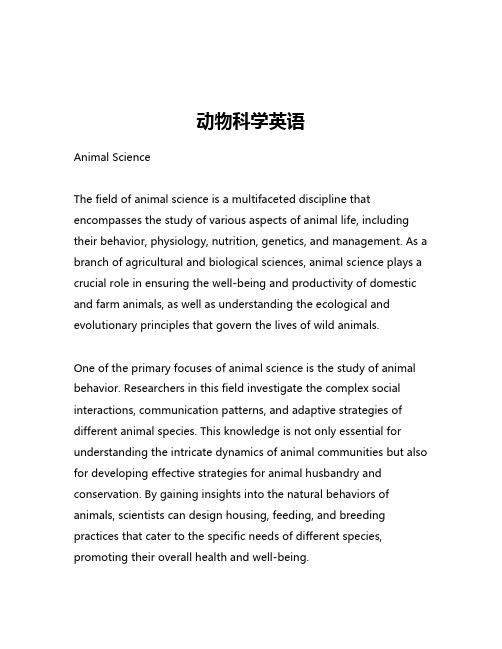
动物科学英语Animal ScienceThe field of animal science is a multifaceted discipline that encompasses the study of various aspects of animal life, including their behavior, physiology, nutrition, genetics, and management. As a branch of agricultural and biological sciences, animal science plays a crucial role in ensuring the well-being and productivity of domestic and farm animals, as well as understanding the ecological and evolutionary principles that govern the lives of wild animals.One of the primary focuses of animal science is the study of animal behavior. Researchers in this field investigate the complex social interactions, communication patterns, and adaptive strategies of different animal species. This knowledge is not only essential for understanding the intricate dynamics of animal communities but also for developing effective strategies for animal husbandry and conservation. By gaining insights into the natural behaviors of animals, scientists can design housing, feeding, and breeding practices that cater to the specific needs of different species, promoting their overall health and well-being.Another crucial aspect of animal science is the study of animal physiology, which delves into the intricate inner workings of animal bodies. This encompasses the examination of various bodily systems, such as the circulatory, respiratory, digestive, and reproductive systems, and how they function in response to different environmental and physiological conditions. Understanding animal physiology is crucial for the development of effective medical treatments, the prevention and treatment of diseases, and the optimization of animal productivity in agricultural settings.Nutrition is another fundamental component of animal science, as it directly impacts the health, growth, and productivity of animals. Researchers in this field investigate the nutritional requirements of different animal species, the composition and properties of various feedstuffs, and the ways in which diet can be tailored to meet the specific needs of individual animals or herds. This knowledge is essential for designing balanced and cost-effective feeding programs that support the optimal growth, reproduction, and overall well-being of animals.The study of animal genetics is another important aspect of animal science, as it allows for the selective breeding of animals to improve desirable traits, such as increased milk or meat production, disease resistance, and enhanced reproductive efficiency. Advances in genomic technologies have revolutionized the field of animalgenetics, enabling researchers to identify and manipulate the genetic factors underlying these important characteristics. By understanding the genetic basis of animal traits, scientists can develop more efficient and sustainable breeding programs that cater to the specific needs of various agricultural and conservation efforts.In addition to these core areas, animal science also encompasses the study of animal management, which involves the practical application of scientific principles to the care and handling of domestic and farm animals. This includes the design and implementation of housing systems, the development of health and welfare protocols, and the optimization of production practices. Effective animal management is essential for ensuring the well-being of animals, maximizing their productivity, and minimizing environmental impact.The field of animal science also plays a crucial role in the conservation of endangered species and the restoration of natural habitats. Researchers in this field work closely with wildlife biologists and conservationists to study the ecology, behavior, and population dynamics of wild animals, and to develop strategies for their protection and sustainable management. This knowledge is essential for developing effective conservation programs that balance the needs of both animals and human communities.Overall, animal science is a dynamic and multifaceted field that spans a wide range of disciplines, from the study of animal behavior and physiology to the optimization of animal production and the conservation of endangered species. Through the application of scientific principles and the development of innovative technologies, animal scientists are making significant contributions to the well-being of animals, the sustainability of agricultural practices, and the preservation of natural ecosystems. As the world faces increasing challenges related to food security, environmental sustainability, and biodiversity conservation, the role of animal science in addressing these issues continues to grow in importance.。
动物科学专业英语部分专业名词复习资料

dominance 显性.(n)dominant .adj recessiveness 隐性.n chromosome染色体.n chromatin染色质epistasis 上位.(n)ep i static genes 上位基因allele等位基因domestic animals;livestoc k家畜qualitative traits 质量形状quantitative traits 数量形状hidden genes隐性基因testcross 测交variation变异reproduction techniques 繁殖技术ovulation 排卵Cross breeding杂交( interbreed ) avian鸟/禽类(.adj)aves (.n)genetic 遗传avian / poultry science禽类科学animal science 动物科学animalhusbandry畜牧业cranial / skull头盖骨cranium颅骨Arraycervical vertebra 颈椎pelvis骨盆urine尿feces 粪Plasma血浆the red blood cells红细胞(erythrocyteswhite blood cell白细胞四肢(前后肢体)pectoral appendage 胸肢(the pectoral limb 前肢the pelvic limb后肢)taxonomy分类学castrate(.v)阉割castrated(.adj)imprinting印记loin腰dorsal(.adj)背the hemoglobin molecules血红蛋白heart 心liver肝spleen脾stomach胃kidney肾lung肺large intestine大肠small intestine 小肠glucose葡萄糖vitamin 维生素starch 淀粉mineral substance矿物质(minerals)nutrition/nutrients营养respiratory system 呼吸系统digestive system 消化系统urinary systems泌尿系统reproductive system 生殖系统circulatory system循环系统atria(.pl)atrium(.n)心房ventricle 心室artery动脉vein静脉The trachea branch气管(trachea)bronchus支气管(.n)bronchi(.pl)the bronchioles branch细支气管herbivores 草食动物omnivores poultry杂食动物carnivores 肉食动物ruminate (.v)反刍ruminant(.n)Bolus食团ruminant animal反刍动物rumen 瘤胃uterus子宫ovaries(.pl)卵巢(ovary)capillary血管ovum卵子heritability遗传力Testis睾丸sperm精子fallopian tubes输卵管domesticate(.v)驯化domestic(.adj)domestication(.n)界门口纲目科属种(kingdom phyla classes orders families genera species)Parturition 分娩thyroid gland甲状腺adrenal glands 肾上腺Pituitary / hypophysis垂体hormone 激素Prolactin 催乳素growth hormone生长激素oxytocin催产素gametes 配子(.pl)zygote 合子(受精卵)Foodstuff饲料roughages粗饲料vertebrate脊椎动物species物种Mate / copulation交配behavior行为(reproductive behavior 生殖行为)Heat / estrus 发情cytoplasm细胞质Cell membrane 细胞膜cell nucleus 细胞核abdominal cavity 腹腔thoracic cavity胸腔bony骨骼axial skeleton中轴骨bony joint骨关节urethra尿道cortex皮质medulla髓质embryo胚胎fetus胎儿breed品种strains 品系beef cattle肉牛dairy cattle奶牛diaphragm 膈肌chromatid 染色单体haploid单倍体diploid二倍体meiosis减数分裂mitosis有丝分裂前中后末四个时期(prophase metaphase anaphase telophase)interphase间期Pancreas胰腺salivary glands唾液腺gall bladder胆囊estrus period 发情期target organ 靶器官amino acid氨基酸protein蛋白质ingestive / prehension采食(.n)ferment(.n,v)发酵fermentation (.n)fallopian tubes输卵管silage fodder青贮饲料full bloom盛花期cellulose 纤维素homoeothermic 恒温动物poultry 家禽enzymes酶(.pl)follicles毛囊distribution分布/分配hyaline cartilage透明软骨elastic cartilage弹性软骨skeletal system 骨骼系统digestive tract 消化道buffering agents 缓冲液clotting mechanism凝血hormone 激素urinary bladder膀胱female reproductive system 雌性生殖系统joint 关节litter-bearing 多产子的sheep goat羊castration 去势fertilization受精ruminants 反刍动物concentrated feeds 浓缩料fertile offspring 可育后代weaning time 断奶sliding joints 滑动关节eliminative排泄weaning time断奶sliding joints 滑动关节progeny后代inbreeding近交outbreeding 远交feed efficiency饲料利用率weaning weight断奶重milk production产奶量egg production 产蛋量postweaning growth rate断奶后增长速率capillary 毛细血管replacement gilts后备母猪hogs 肥育猪nephron肾单位alveoli 肺泡glottis声门epiglottis会咽nasal cavity鼻腔。
大学中的各学院专业英语名称

大学中的各学院专业英语名称学院简称专业名称专业简称农学院农学Agronomy 农学植物科学与技术Plant Science and Technology 植科种子科学与工程Seed Science and Engineering 种子植保学院植物保护Plant Protection 植保制药工程Pharmaceutical Engineering 制药园艺学院园艺Horticulture 园艺设施农业科学与工程Facility Agriculture Science and Engineering 设施动科学院动物科学Animal Science 动科草业科学Pratacultural Science 草业水产养殖Aquaculture 水产林学院林学Forestry 林学园林Landscape and Gardening园林林产化工Chemical Processing of Forest 林化艺术设计Artistic Designing艺术森林资源保护与游憩Forest Resources 森保资环学院资源环境与城乡规划管理Urban and ural Planning & Resource Management 城管资源环境科学(农业资源与环境)Resources and Environmental Sciences 资环环境科学Environmental Science环科地理信息系统Geographical Information System 地信水建学院水文与水资源工程Hydrology and Water Resource Engineering 水文农业水利工程Agricultural Water Conservancy Engineering农水热能与动力工程Thermal Energy and Power Engineering 热动农业建筑环境与能源工程Agricultural Structure, Environment and Energy Engineering 农建水利水电工程Water Conservancy and Hydropower Engineering 水工土木工程Civil Engineering土木电气工程及其自动化Electrical Engineering and Automation 电气城市规划Urban Planning 城规机电学院电子信息工程Electronic Information Engineering 电信机械电子工程Mechatronic Engineering 机电机械设计制造及其自动化Mechine Design & Manufacturing and Automation 机制农业机械化及其自动化Agricultural Mechanization and Automation 机化农业电气化与自动化Agricultural Electrification and Automation 农化包装工程Packaging Engineering 包装工业设计Industry Design工设木材科学与工程Wood Science and Engineering 木材信息学院计算机科学与技术Computer Science and Technology 计算机信息管理与信息系统Information Management and Information System 信管软件工程Software Engineering软件食品学院食品科学与工程Food Science and Engineering 食工食品质量与安全Food Quality and Safety Engineering 食安葡酒学院葡萄与葡萄酒工程(酿酒工程)Viticulture and Enological Engineering 葡酒生命学院生物技术Biotechnology 生技生物工程Bioengineering生工生物科学Biological Science生科经管学院国际经济与贸易International Economics and Trade 国贸会计学Accounting会计金融学Finance金融土地资源管理Land Resources Management 土管经济学Economics经济农林经济管理Agricultural/ Forest Economy Management 农经工商管理Business Administration工商电子商务Electronic Commerce电商旅游管理(森林资源保护与游憩)Tourism Management 旅管公共事业管理Public Utilities Management 公管市场营销Marketing营销保险Insurance保险人文学院法学Law 法学社会学Sociology社会政治学与行政学Political Science and Administrative Science 行政理学院应用化学Applied Chemistry 应化信息与计算科学Information and Computing Science 信计动医学院动物医学Animal Medicine 动医外语系英语English英语创新学院国家生命科学与技术人才培养基地班(生物技术)National Training Base for Life Science and Technology (Biotechnology)生技基地班国家生命科学与技术人才培养基地班(生物工程)National Training Base for Life Science and Technology(Bioengineering)生工基地班植物科学类创新实验班Innovation Experiment of Plant Science植科创新班经济管理类创新实验班Innovation Experiment of Economy Management经管创新班动物科学类创新实验班Innovation Experiment of Animal Science动科创新班轻加工类创新实验班Innovation Experiment of Light Industry轻工创新班。
动物药学专业英语

动物药学专业英语English:In the field of animal medicine, students will learn about the anatomy, physiology, and pharmacology of animals. They will also study the diseases that affect animals and the various treatment options available. This may include learning about different types of medications, vaccines, and surgical techniques used in animal medicine. Students will also gain a strong understanding of animal behavior and husbandry practices, as well as the ethical considerations involved in the treatment of animals. Additionally, they may have the opportunity to gain hands-on experience through internships or clinical rotations at veterinary practices or animal hospitals.中文翻译:在动物药学专业领域,学生将学习动物的解剖学、生理学和药理学知识。
他们还将学习影响动物的疾病和各种治疗选择。
这可能包括学习动物药品、疫苗以及动物药学中使用的不同手术技术。
学生还将深入了解动物行为和畜牧实践,以及动物治疗中涉及的伦理考虑。
此外,他们可能有机会通过在兽医诊所或动物医院的实习或临床轮转来获得实践经验。
动物科学专业英语

动物科学专业英语English:The study of animal science involves the scientific understanding of the biology and behavior of domestic and wild animals. This field encompasses various aspects including genetics, nutrition, reproduction, animal health, and welfare. Animal scientists work to understand the physiological and anatomical makeup of different species, how they interact with their environment, and how to improve their overall well-being. Additionally, animal science also plays a crucial role in food production and farm management, ensuring the efficient and ethical care of livestock. With a focus on sustainability and ethical treatment, animal science professionals strive to develop innovative solutions to improve animal health and production while minimizing negative environmental impact.中文翻译:动物科学的研究涉及对家畜和野生动物生物学和行为的科学了解。
动物医学的英语
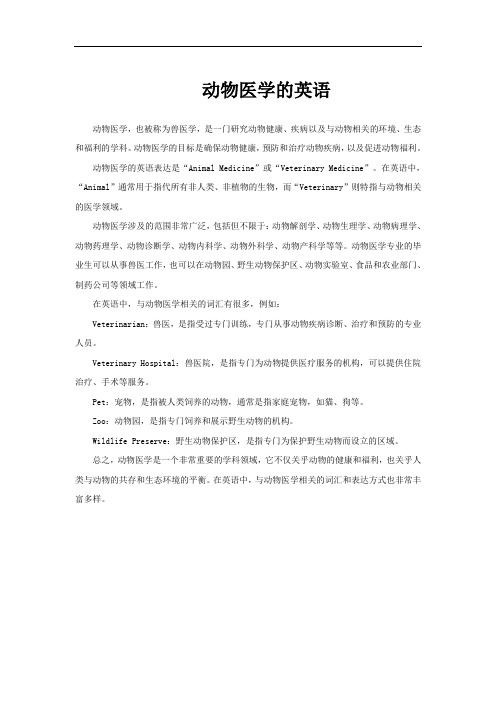
动物医学的英语
动物医学,也被称为兽医学,是一门研究动物健康、疾病以及与动物相关的环境、生态和福利的学科。
动物医学的目标是确保动物健康,预防和治疗动物疾病,以及促进动物福利。
动物医学的英语表达是“Animal Medicine”或“Veterinary Medicine”。
在英语中,“Animal”通常用于指代所有非人类、非植物的生物,而“Veterinary”则特指与动物相关的医学领域。
动物医学涉及的范围非常广泛,包括但不限于:动物解剖学、动物生理学、动物病理学、动物药理学、动物诊断学、动物内科学、动物外科学、动物产科学等等。
动物医学专业的毕业生可以从事兽医工作,也可以在动物园、野生动物保护区、动物实验室、食品和农业部门、制药公司等领域工作。
在英语中,与动物医学相关的词汇有很多,例如:
Veterinarian:兽医,是指受过专门训练,专门从事动物疾病诊断、治疗和预防的专业人员。
Veterinary Hospital:兽医院,是指专门为动物提供医疗服务的机构,可以提供住院治疗、手术等服务。
Pet:宠物,是指被人类饲养的动物,通常是指家庭宠物,如猫、狗等。
Zoo:动物园,是指专门饲养和展示野生动物的机构。
Wildlife Preserve:野生动物保护区,是指专门为保护野生动物而设立的区域。
总之,动物医学是一个非常重要的学科领域,它不仅关乎动物的健康和福利,也关乎人类与动物的共存和生态环境的平衡。
在英语中,与动物医学相关的词汇和表达方式也非常丰富多样。
动物科学专业英文词汇汇总

Abomasum 真胃、皱胃Absorption 吸收Accurate devices精密仪器Acetate 乙酸盐Acetic acid 乙酸Alfalfa 苜蓿Alimentary tract 消化道Amino acid 氨基酸Ammonium salts 铵盐Animal herds 畜群Animal population 动物种群Animal species 动物种类Antibiotics 抗生素Apparent digestibility 表观消化率Apparent digestible energy 表观消化能Applied mathematical science of statistics 应用统计数学Appraising livestock 家畜评定Artificial insemination人工授精Bacteria 细菌Bacterial protein 菌体蛋白Beef breeds 肉用牛Breed 品种、育种、繁殖Breeder 育种者Breeding animal 种畜Breeding cycle 繁殖周期Breeding farm 育种场Breeding house 种畜舍Breeding performance繁殖性能Breeding stock 种畜Breeding system 育种系统Breeding 育种、配种Bull 公牛Butterfat 乳脂Butyrate 丁酸盐Butyric acid 丁酸B-vitamins B族维生素Caecum 盲肠(cecum)Capillaries 毛细血管Carbohydrates 糖类Carcass composition 胴体组成Carcass fat 胴体脂肪Carcass grade 胴体等级Carcass quality 胴体品质Carcass traits 胴体性状Carcass weight 胴体重Carcass yield 屠宰率Carcass 胴体Causative agent 病因Cellulose 纤维素Cholera 霍乱Commercial use 商业应用Complex carbohydrates 复杂糖Concentrates 精饲料Conception rate 受胎率Confinement buildings舍饲建筑Confinement feeding 密集圈养Confinement rearing 集约饲养Confinement 舍饲、集约饲养Confirmation 体型Contagious diseases 接触传染病Controlled studies 对照试验Crossbreeding 杂交Crude fiber 粗纤维Crude protein 粗蛋白Culling 淘汰Deficiency diseases 营养缺乏症Developing embryos 发育胚胎Diet 日粮Dietary proteins 日粮蛋白Digest\digestion 消化Digesta 消化物Digestibility 消化率Digestible nutrient可消化养分Digestive tract 消化道Disease-carrying organism 带病菌Disease-combating 抗病Disease-producing organism治病菌Diseases transmission疾病传播Diseases-causing agents致病物Domestic animal 家畜Domestic livestock 家畜Domestic sheep 绵羊Domestication 驯化Donor 捐赠者Drought 干旱Drugs 药物Dry matter 干物质Dry-matter intake干物质摄入Economic trait 经济性状Electrical conductivity导电性能Embryo transfer 胚胎移植Embryo 胚胎Embryonic development胚胎发育Environmental factor环境因子Enzymes 酶Esophagus 食管、食道Essential amino acid必需氨基酸Ether extract 乙醚浸出物Excrement 排泄物Farm animal 家畜Farrow 产仔Farrowing house 产仔舍Farrowing sow 待产母猪Fatten 育肥、催肥Fattening cattle 育肥牛Fattening feed 育肥饲料Fattening unit 育肥场Fattening 育肥、催肥Fecal energy 粪能Feed additives 饲料添加剂Feed consumption 饲料消耗量Feed conversion efficiency 饲料报酬Feed efficiency 利用率Feed evaluation 饲料评估Feed formula 饲料配方Feed formulation 饲料配合Feed industry 饲料工业Feed ingredients 饲料成分、饲料原料Feed processing 饲料加工Feed production 饲料加工Feed requirement 饲料需要量Feed utilization 饲料转化率Feed\feedstuff\foodstuff\feeding stuff 饲料Feeding floors 饲喂间地面Feedlot 育肥场Female reproductive cell 雌性生殖细胞Fermentable 可发酵的Fermentation end products 发酵终产物Fermentation product发酵产物Fermentation 发酵Fertilization\fertilize 受精Fertilized ova 受精卵Fiber 纤维Fluids 体液Foot-and-mouth-diseases 口蹄疫Forage 牧草Forestomach 前胃Fungi 真菌Gaseous energy 气能Genetic improvement遗传改良Genetic make-up 遗传表现Genetic potential 遗传潜力Genetic trait 遗传性状Genetics 遗传学Grains 谷物Grazing animal 放牧动物Grazing behavior 放牧习性Grazing capacity 载畜量Grazing land 放牧草地Grazing systems 放牧制度Gross energy 总能Growing-finishing pig 生长育肥猪Heat increment 热增耗Heavy grazing 重载Herbivore 食草动物Herbivorous animals 食草动物Hereditary character遗传性状Hereditary diseases 遗传性疾病Heredity 遗传Highly correlate 高度相关的Hog producer 生猪生产者Homogeneous traits 纯和性状Hormones 激素Humidity 湿度Hydrolyze\hydrolysis 水解Identical twins 同卵双胞胎Immune globulins 免疫球蛋白Indigestible 不可消化的Ingestions 摄食Inherit 遗传Inherited character 遗传性状Inherited diseases遗传性疾病Inherited trait 遗传性状Inhibitory 抑制Inseminate 授精Insemination 授精Intensive farming 集约化农业、集约化畜牧业Intensive farming 集约农场Intensive grazing 集约放牧Intensive system 集约饲养制Junction 接缝、关节Large intestine 大肠Legumes 豆科植物Life cycles 生活史Lignin 木质素Lipid 脂类Livestock breeders畜牧生产者Livestock farm 畜牧场Livestock growers 畜牧生产者Livestock industry 畜牧业Livestock management家畜管理Livestock producers 养畜者、畜牧经营者Livestock production 畜牧生产Livestock 家畜Lymphatic system 淋巴系统Mad cow diseases 疯牛病Mammalian enzyme哺乳动物酶Manure disposal 粪便处理Manure pit 粪坑Manure 粪肥Massive production of ova 卵子大量生产Mastitis 乳房炎Maturity 成熟Meat industry 肉产业Meat-type animal 肉用家畜Mechanical ventilation 机械通风Metabolic diseases 代谢病Metabolic 代谢的Metabolism cage 代谢笼Metabolism 代谢Metabolite 代谢物Metabolizable energy 代谢能Metabolizable protein 代谢蛋白Metabolizable 可代谢的Metabolization 代谢Metabolize 代谢Methane 甲烷Microbial action 微生物作用Microbial activity 微生物活性Microbial digestion 微生物消化Microflora 微生物区系Microorganisms 微生物Minerals 矿物质Monogastric animal 单胃动物Monosaccharides 单糖Muscling 瘦肉率Mutate\mutation 突变Natural selection 自然选择Natural ventilation 自然通风Net energy 净能Newcastle diseases 新城疫N-free extract 无氮浸出物Nitrogenous compounds 含氮化合物Non-protein nitrogen 非蛋白氮Nonruminants 单胃动物Nursery house 保育舍Nutrient deficiency 营养缺乏Nutritive requirement营养需要Offspring 后代Omasum 瓣胃Omnivore 杂食动物Organic matter 有机质Organs 器官Over grazing 超载Parturition 分娩Pasture improvement 草地改良、牧草改良Pasture land 牧草地、草原Pasture management牧地管理Pasture production 牧草生产Pasture stock 放牧家畜Pasture yield 产草量Pedigree 系谱\血统Physiological processes 生理过程Physiological state 生理状态Physiology of reproduction 生殖生理Piglet 仔猪Polysaccharides 多糖Product quality 产品质量Production trait 生产性状Productive traits 生产性能Prolificacy 繁殖力Propionate 丙酸盐Propionic acid 丙酸Protein 蛋白质Protozoa 原虫Purebred 纯种Quarantine 隔离Quarter 乳区Radiant energy 辐射能Radiant heat 辐射热Rating animal 家畜评定Ration 日粮Relative humidity 相对湿度Replacement female 后备母畜Replacement sows 后备母猪Reproduction trait 繁殖性状Reproductive cells 繁殖细胞Reproductive cycle 繁殖周期Reproductive efficiency 繁殖力Reproductive organs 生殖器官Reproductive performance 繁殖性能Reproductive potential繁殖潜力Reproductive rate 繁殖率Reproductive tract 生殖道Reproductivity 繁殖力Retention 滞留、保持Reticulum 网胃Rumen bacteria 瘤胃细菌Rumen 瘤胃Ruminal bacteria 瘤胃细菌Ruminant animal 反刍动物Ruminant 反刍动物Rumination 反刍Sanitary\sanitation 卫生Scrapie 痒病Selection 选择、选种Selective breeding 选配、选育Semen 精液Short chain fatty acid 短链脂肪酸Silage 青贮饲料Simple-stomached animals 单胃动物Sire 公畜Slaughter weight 屠宰重Small intestine 小肠Sow 母猪Sperm 精子Sprinklers 喷淋头Starch 淀粉Statistical formulas 统计公式Supplement 补充、添加Supplemental feed 补充饲料Supplementary feeding 补饲Survival of the fittest适者生存Susceptibility 敏感性Susceptible 易受影响的Swine fever 猪瘟Synthesize 合成Teat 乳头Tissues 组织Trait 性状Transmit\transmission 传播Transmitting ability遗传能力Urea 尿、尿素Vaccines 疫苗Volatile fatty acid 挥发性脂肪酸Waste treatment 排泄物处理。
动物科学 医学 专业英语

专业英语复习资料一、缩写1.VFA:V olatile Fatty Acids 挥发性脂肪酸2.DM:Dry Matter 干物质3.CP:Crude Protein 粗蛋白4.CF:Crude Fiber 粗纤维5.NDF:Neutral Detergent Fiber 中性洗涤纤维6.EE:Ether Extract 乙醚提取物(粗脂肪)7.ADF:Acid Detergent Fiber 酸性洗涤纤维8.NE L:Net Energy of Lactation泌乳净能9.NPN:Non-Protein Nitrogen 非蛋白氮10.V A:Vitamins A 维生素A二、翻译1.Forage:粗饲料2.Concentrate:精饲料3.Mineral:矿物质4.Glucose:葡萄糖5.Rumen:瘤胃6.Animal nutrition:动物营养7.Protein metabolism:蛋白质代谢8.Digestion:消化9.Small intestine:小肠10.Diet:饲粮三、名词解释:1.Feeds: Feeds contain nutrients that are used to meet the requirements of animals.2.Lipids:Lipids are substances which are water insoluble, but are soluble in organic solvents.Lipids are usuallyextracted from oilseeds3.Dry matter:When a feed sample is placed in an oven maintained at 105°C for 24 hours, the water evaporatesand the residual dry feed is called dry matter.4.Genetics:Genetics is a science that studies the variation and transmission of features or traits from onegeneration to the next.5.Genotype:The genotype of an animal represents the gene or the set of genes responsible for a particular trait.6.Ketosis:is a metabolic disorder occurring in cows with insufficient or excess body reserve at calving—cowslose their appetites,and milk production and fertility decrease.四、翻译题1、Dairy cows and other animals such as sheep, goats, buffaloes, camels and giraffes are herbivores because their diets are composed primarily of plant material. Many herbivores also are ruminants.Ruminant animals can be recognized easily because they chew frequently even when they are not eating. This chewing activity called rumination , is part of the processes that allow a ruminant to obtain energy from plant cell walls also called fiber .奶牛和其它动物如绵羊、山羊、水牛、骆驼和长颈鹿都属于草食动物。
兽医专业英语
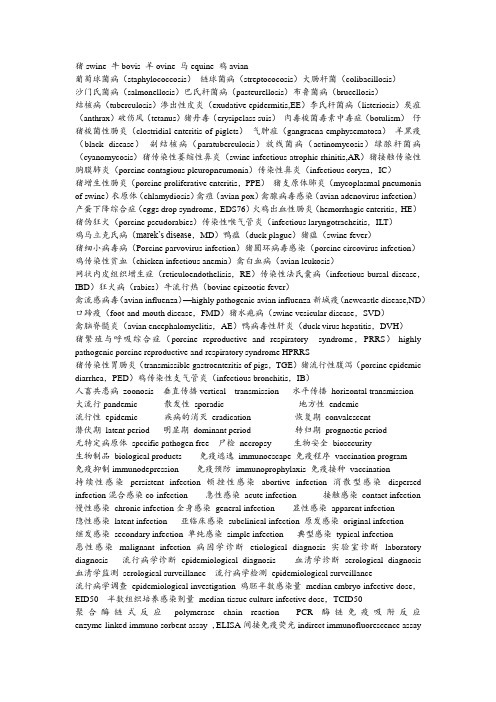
猪传染性胃肠炎(transmissible gastroenteritis of pigs,TGE)猪流行性腹泻(porcine epidemic diarrhea,PED)鸡传染性支气管炎(infectious bronchitis,IB)
死亡率mortality发病率morbidity
猪伪狂犬(porcine pseudorabies)传染性喉气管炎(infectious laryngotracheitis,ILT)
鸡马立克氏病(marek’s disease,MD)鸭瘟(duck plague)猪瘟(swine fever)
猪细小病毒病(Porcine parvovirus infection)猪圆环病毒感染(porcine circovirus infection)
鸡传染性贫血(chicken infectious anemia)禽白血病(avian leukosis)
网状内皮组织增生症(reticuloendothelisis,RE)传染性法氏囊病(infectious bursal disease,IBD)狂犬病(rabies)牛流行热(bovine epizootic fever)
持续性感染persistent infection顿挫性感染abortive infection消散型感染dispersed infection混合感染co-infection急性感染acute infection接触感染contact infection
兽医专业英语书

兽医专业英语书兽医专业英语书籍主要针对兽医学领域的专业人士和学生设计,旨在提升他们在专业领域内的英语阅读、写作及沟通能力。
以下是一些常见的兽医专业英语教材或参考书:1. 《Veterinary English》作者:不详(因该类书籍众多,具体作者可能不同)内容概述:本书通常包括兽医术语的详细解释、专业文章阅读理解、案例分析以及实际工作场景对话等部分,帮助读者掌握兽医学专业的英语词汇和表达方式。
2. 《English for Veterinary Nurses and Technicians》作者:Linda祀尔顿(Linda H. Dalton) 等内容概述:专门针对兽医护理员和技术人员编写的英语教材,涵盖了动物护理、疾病诊断与治疗、手术室用语等多个方面。
3. 《Professional English in Use: Medicine》作者:Michael McCarthy, Felicity O’Dell虽然不是专门针对兽医,但此书作为医学专业英语的经典教材,也包含大量可用于兽医领域的通用专业词汇和句型,适合有一定基础的兽医专业学生或从业者提高专业英语水平。
4. 《Veterinary Terminology: A Comprehensive Guide》作者:Beverly C. Szczur内容概述:这是一本全面的兽医术语指南,有助于学习者掌握和记忆大量的兽医专业词汇。
5. 《Animal Science and Veterinary Terminology》作者:Barbara A. McClung内容概述:这本书专为动物科学和兽医专业的学生编写,提供了丰富的专业词汇,并结合实例进行讲解。
在选择兽医专业英语书籍时,可以根据自己的需求(如是否需要考试准备、职业发展或日常工作中使用)以及自身的英语水平来挑选合适的教材。
同时,还可以利用在线资源和专业期刊进一步提升专业英语技能。
兽医专业英语
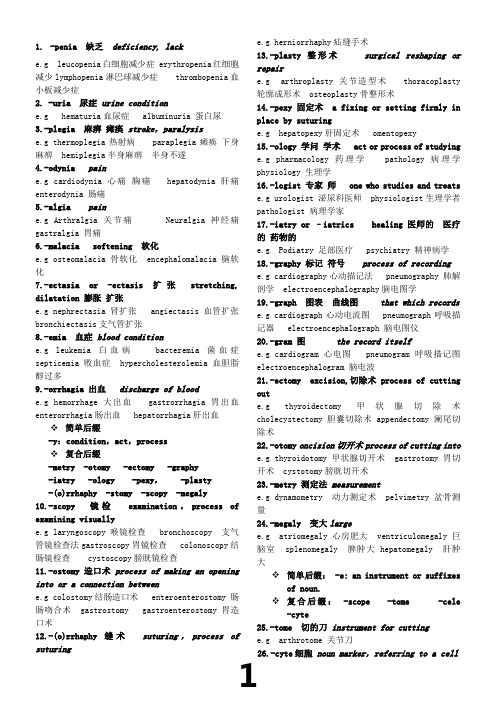
1.-penia 缺乏deficiency, lacke.g leucopenia白细胞减少症 erythropenia红细胞减少lymphopenia淋巴球减少症 thrombopenia血小板减少症2. -uria 尿症urine conditione.g hematuria血尿症 albuminuria 蛋白尿3.-plegia 麻痹瘫痪stroke,paralysise.g thermoplegia热射病 paraplegia瘫痪下身麻痹 hemiplegia半身麻痹半身不遂4.-odynia paine.g cardiodynia心痛胸痛 hepatodynia肝痛enterodynia 肠痛5.-algia paine.g Arthralgia 关节痛Neuralgia神经痛gastralgia 胃痛6.-malacia softening 软化e.g osteomalacia 骨软化 encephalomalacia 脑软化7.-ectasia or -ectasis 扩张stretching, dilatation 膨胀扩张e.g nephrectasia肾扩张 angiectasis 血管扩张bronchiectasis支气管扩张8.-emia 血症blood conditione.g leukemia白血病bacteremia菌血症septicemia 败血症 hypercholesterolemia血胆脂醇过多9.-orrhagia 出血discharge of bloode.g hemorrhage大出血 gastrorrhagia 胃出血enterorrhagia肠出血 hepatorrhagia肝出血 简单后缀-y:condition,act,process复合后缀-metry -otomy -ectomy -graphy-iatry -ology -pexy, -plasty-(o)rrhaphy -stomy -scopy -megaly10.-scopy 镜检examination,process of examining visuallye.g laryngoscopy喉镜检查 bronchoscopy 支气管镜检查法gastroscopy胃镜检查 colonoscopy结肠镜检查 cystoscopy膀胱镜检查11.-ostomy 造口术process of making an opening into or a connection betweene.g colostomy结肠造口术 enteroenterostomy 肠肠吻合术 gastrostomy gastroenterostomy胃造口术12.-(o)rrhaphy缝术suturing,process of suturing e.g herniorrhaphy疝缝手术13.-plasty整形术surgical reshaping or repaire.g arthroplasty关节造型术 thoracoplasty轮廓成形术 osteoplasty骨整形术14.-pexy 固定术 a fixing or setting firmly in place by suturinge.g hepatopexy肝固定术 omentopexy15.-ology 学问学术 act or process of studyinge.g pharmacology药理学pathology病理学physiology 生理学16.-logist 专家师 one who studies and treatse.g urologist 泌尿科医师 physiologist生理学者pathologist 病理学家17.-iatry or –iatrics healing 医师的医疗的药物的e.g Podiatry 足部医疗 psychiatry 精神病学18.-graphy 标记符号process of recordinge.g cardiography心动描记法 pneumography 肺解剖学 electroencephalography脑电图学19.-graph 图表曲线图that which recordse.g cardiograph心动电流图 pneumograph呼吸描记器 electroencephalograph 脑电图仪20.-gram 图the record itselfe.g cardiogram心电图 pneumogram 呼吸描记图electroencephalogram 脑电波21.-ectomy excision,切除术process of cuttingoute.g thyroidectomy甲状腺切除术cholecystectomy 胆囊切除术 appendectomy 阑尾切除术22.-otomy oncision切开术process of cutting intoe.g thyroidotomy 甲状腺切开术 gastrotomy 胃切开术 cystotomy膀胱切开术23.-metry 测定法measuremente.g dynamometry 动力测定术 pelvimetry盆骨测量24.-megaly 变大largee.g atriomegaly 心房肥大 ventriculomegaly 巨脑室 splenomegaly 脾肿大 hepatomegaly 肝肿大简单后缀: -e: an instrument or suffixes of noun.复合后缀:-scope -tome -cele -cyte25.-tome 切的刀instrument for cuttinge.g arthrotome 关节刀26.-cyte细胞noun marker,referring to a cell12e.g leukocyte 包细胞 lymphocyte 淋巴细胞 hepatocyte 肝细胞 lipocyte 脂肪细胞27.-cele 疝 突出 膨大 hernia ,herniatione.g thyrocele 甲状腺肿 hepatocele 肝脏突出 pneumocele 肺彭出 omphalocele 脐突出 28.-scope 镜检 instrument for viewinge.g laryngoscope 喉镜检 bronchoscope 气管镜检 celioscope 腹腔境 gastroscope 胃窥镜 29.-itis 炎症 inflammatione.g hepatitis 肝炎 peritonitis 腹膜炎 gastroenteritis 肠胃炎30.-ist 专家 one who specializes in----e.g gastroscopist 胃镜医师 enterologist 肠病学家 pathologist 病理学家 neuropathist 神经病学家31.-or (er ) refers to a doer, either a personor thing e.g incisor 门齿,切牙 32.-osis 症状 a condition, usually abnormal or pathological e.g sclerosis 硬化症 hepatosis 肝机能病 gastrosis 胃病 nephrosis 肾病 33.-oma 肿瘤 swelling ,tumor e.g sarcoma 肉瘤 恶性肿瘤 fibroma 纤维瘤 hepatoma 肝细胞瘤 lipoma 脂肪瘤 34.-ism a condition, usually the result of a prior condition (先决条件) e.g embolism 栓塞 栓子 35.-(i )um refers to a part in relation to a whole, related to e.g pericardium 心包膜 epigastrium 腹上第一腹片 bronchium 支气管 44.-meter 仪表 instrument for measuring e.g thermometer 温度计 体温计 pulmometer 肺量计 pulsimeter 脉搏计 45.-(o )rrhea 释放 排放 flow , discharge e.g diarrhea 腹泻 gastrorrhea 胃液分泌过多 46.-lysis 溶解 dissolution ;decomposition e.g Hemolysis 溶血 bacteriolysis 溶菌 47.-pathy 病变disease, diseased condition e.g ophthalmopathy hepatopathy 肝病 gastropathy 胃病 nephropathy 肾病 48.-blast 母细胞 a cell that is undifferentiated, primitive, embryonic e.g hemocytoblast 原始血细胞 enteroblast 成肠细胞 fibroblast 成纤维细胞 49.-centesis 穿刺术 surgical puncture to withdraw fluid enterocentesis thoracocentesise.g amniocentesis 羊膜腔穿刺术 abdominocentesis 腹腔穿刺术50.-clysis 灌肠 打点滴 washing, introductionof fluid for the purpose of irrigatione.g bronchoclysis 野马灌肠51.-ptosis 下垂症 a falling, the dropping or sagging of an organe.g nephroptosis 肾下垂 hepatoptosis 肝下垂 gastroptosis 胃下垂 enteroptosis 肠下垂 52.-ptysis 吐涎e.g hemoptysis 咯血 emptysis 吐血 pyoptysis 咯脓53.-(o )rrhexis 破裂 rupture e.g hepatorrhexis 肝破裂54.-sclerosis 硬化症a hardeninge.g arteriosclerosis 动脉硬化 hepatosclerosis 肝硬化 nephrosclerosis 肾硬化 55.-stasis 静止 arresting ,halting e.g bacteriostasis 细菌抑制 56.-stenosis 狭窄 a narrowing, a stricture e.g Arteriostenosis 动脉狭窄 57.-emesis 呕吐 e.g emetic 催吐要 antiemetic 止吐药 Word Roots 1. cor- or cardi(o)- 心的 heart --- cordiform 心形的 ---cordate 心脏形的 --- cardialgia 心痛 --- cardiogram 心电图 2. hepato- pref 肝 liver --- hepatodynia 肝痛 --- hepatoma 肝细胞瘤 --- hepatopathy 肝病 --- hepatotoxin 肝毒素 3. pulmo- or pneumo- or pneumat(o)- 肺 lung or air --- pulmometry 肺容量测定法 --- pulmonitis 肺炎--- pneumobacillus 肺炎杆菌 --- pneumonectasis 肺气肿--- pneumatolysis 肺气化 --- pneumatometer 肺活量计 4. lien(o)- or spleen(o)-脾 splee --- lienitis 脾炎 --- lienectomy 脾切除--- splenotomy 脾切开术 --- splenomegaly 脾肿大 5. ren(o)- or nephr(o)- kidney --- renin 肾索--- renography 肾X 线照相术 ---nephritis 肾炎 --- nephrolithiasis 肾石病 6. oro- or stomat(o)- mouth --- oropharynx 口咽--- oronasal 口鼻的 --- stomatology 口腔病学 --- stomatitis 口腔炎7. labio- or cheil(o)- lip--- labiodental唇齿音--- labioplasty唇成形术cheilectropion唇外翻 cheiloschisis唇裂8. denti- or odonto- pref. tooth-- dentist--- dentiscalprum牙刮---odontoprosthesis 牙体修复术—odontoseisis牙松动9. linguo- tongue--- lingua舌—linguiform舌装的--- lingulate 舌装的--- linguodental舌齿音10. gingiv- or ulo- 牙龈 gum---gingivectomy龈切除术—gingivitis齿龈炎---ulorrhagia龈出血---ulorrhoea 龈糁血11. palato- or urano- 腭 palatine---palatitis腭炎---palatogram口盖图---palatograph腭动扫描器palatography腭位图的制作12. pharyngo- 咽 pharynxpharyngalgia咽痛pharyngocele咽囊肿pharyngoplasty咽成形术pharyngoplegia咽肌麻痹13. laryngo- 喉 larynx,throatLaryngalgia喉痛laryngemphraxis喉阻塞laryngostenosis喉狭窄laryngoxerosis喉干燥14. esophag(o)- 食管 esophagus Esophagectasis食管扩张esophagectopy食管异位esophagocele食管突出 esophagotomy食管切开术15. gastr(o)- stomachgastrin 胃泌激素gastrectasia胃胀gastroanastomosis胃吻合术gastroptosis胃下垂16. enter(o)-肠 intestineenterelcosis 肠溃疡enteremphraxis肠阻塞enterorrhagia肠出血enterocolostomy 小肠结肠吻合术17. colo- or coli- or col- pref结肠. colon colicodynia 结肠痛colimycin结肠霉素coloclysis结肠灌洗 colonorrhea粘液性结肠炎18.proct(o)- or archo-直肠 rectumProctectomy直肠切除术proctitis 直肠炎proctoscope直肠镜- proctoscopy直肠镜观察术19.ano-肛门 anusAnogenital肛门与生殖器的anorectal肛门直肠的anorectum肛门直肠部anoscope肛门镜20. vesico- or cysti- or cysto- 膀胱 bladder Vesicotomy膀胱切开术cystirrhagia膀胱出血cystocele 膀胱彭出cystourethritis膀胱尿道炎21. thoraco- chest or 胸 thoraxThoracocyllosis胸畸形thoracicolumbar 胸腰的thoracoschisis 胸裂thoracoplasty胸廓成形术22. ventro- or coeli(o)- or laparo- 腹部 belly、abdomenVentrotomy剖腹术coelialgia腹痛Coeliorrhaphy 腹腔缝术laparotome剖腹术23. bili- or chole-胆 bilebilichol 胆汁醇- biligenic生胆汁的cholecyst胆囊cholelithiasis胆石病24. oculo- or ophthalmo- eyeoculist 眼科医生oculomotor 眼球运动的ophthalmoplegia眼肌麻痹ophthalmoscope检眼镜25. lacrimo- or dacryo-眼泪 tearlacrimator 催泪物质-lacrimal 泪腺的lacrimatory agent催泪剂lacrimation 泪26. palpebro- or blepharo-眼睑 eyelid palpebra 眼睑palpebral 眼睑的blepharochalasis 眼睑皮肤松弛症 blepharospasm眼睑痉挛27. kerato-角角质 horn or comea keratectasia 角膜膨胀keratinase 角蛋白酶keratoplasty 角膜成形术keratosis角化症28.auri- or oto- earauriphone 助听器auristilla滴耳剂 otorrhea耳液溢,耳漏 otosclerosis 耳硬化症29.naso- or rhino- noseNasitis鼻炎nasopharynx 鼻咽 rhinocleisis鼻腔闭塞rhinocnesmus 鼻痒30.broncho- or bronch- 支气管 pref. bronchus; bronchialBronchiectasis支气管扩张bronchiolitis细支气管炎 bronchorrhagia支气管出血bronchospasm支气管痉挛31. gonado- 生殖腺 seedGonadectomy性腺切除术gonadotrophin 促性腺激素gonadotrope 生殖腺32. andro- 男的雄性的 maleandrocentrism大男子主义androgen 雄激素andrology 男科学 androsterone 雄淄酮33. gyne- or gyneco- femaleGynecic女性的gynecium 雌蕊雌蕊群gynecologist 妇科医生gynecopathy 妇科病34. vagino- or colpo- 阴道 vagina Vaginectomy阴道切除术vaginotomy阴道切开术colpoptosis阴道下垂colporrhaphy阴道缝合术35. oophor- 卵巢 ovaryOophorectomy卵巢切除术oophorectomize切除。
动物科学专业英语重点
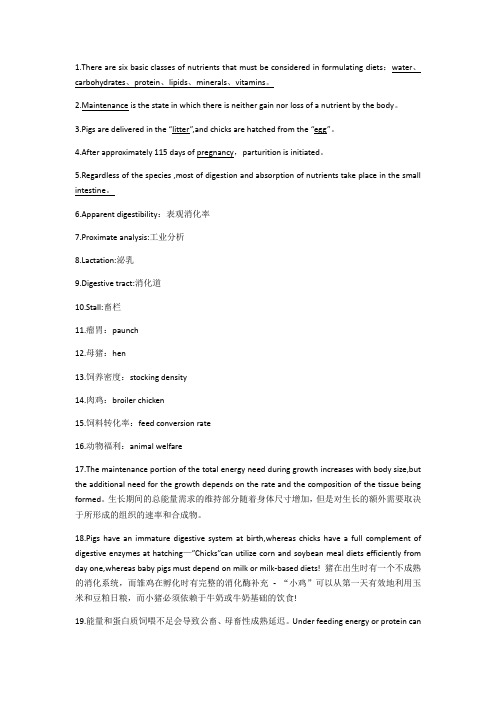
1.There are six basic classes of nutrients that must be considered in formulating diets:water、carbohydrates、protein、lipids、minerals、vitamins。
2.Maintenance is the state in which there is neither gain nor loss of a nutrient by the body。
3.Pigs are delivered in the “litter”,and chicks are hatched from the “egg”。
4.After approximately 115 days of pregnancy,parturition is initiated。
5.Regardless of the species ,most of digestion and absorption of nutrients take place in the small intestine。
6.Apparent digestibility:表观消化率7.Proximate analysis:工业分析ctation:泌乳9.Digestive tract:消化道10.Stall:畜栏11.瘤胃:paunch12.母猪:hen13.饲养密度:stocking density14.肉鸡:broiler chicken15.饲料转化率:feed conversion rate16.动物福利:animal welfare17.The maintenance portion of the total energy need during growth increases with body size,but the additional need for the growth depends on the rate and the composition of the tissue being formed。
兽医专业英语
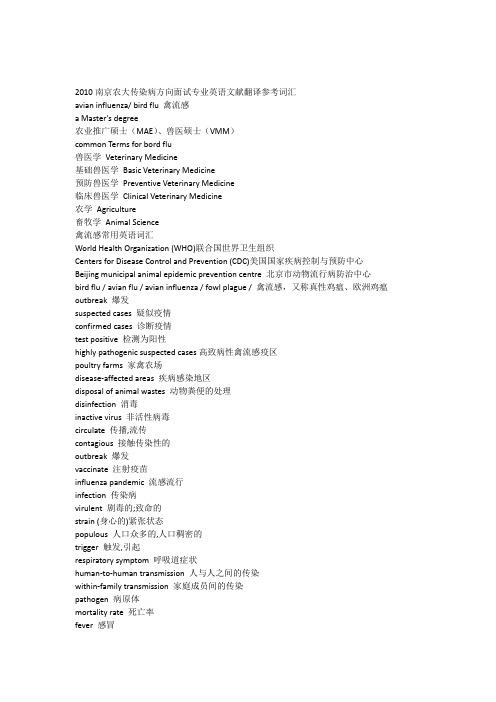
2010南京农大传染病方向面试专业英语文献翻译参考词汇avian influenza/ bird flu 禽流感a Master's degree农业推广硕士(MAE)、兽医硕士(VMM)common Terms for bord flu兽医学Veterinary Medicine基础兽医学Basic Veterinary Medicine预防兽医学Preventive Veterinary Medicine临床兽医学Clinical Veterinary Medicine农学Agriculture畜牧学Animal Science禽流感常用英语词汇World Health Organization (WHO)联合国世界卫生组织Centers for Disease Control and Prevention (CDC)美国国家疾病控制与预防中心Beijing municipal animal epidemic prevention centre 北京市动物流行病防治中心bird flu / avian flu / avian influenza / fowl plague / 禽流感,又称真性鸡瘟、欧洲鸡瘟outbreak 爆发suspected cases 疑似疫情confirmed cases 诊断疫情test positive 检测为阳性highly pathogenic suspected cases高致病性禽流感疫区poultry farms 家禽农场disease-affected areas 疾病感染地区disposal of animal wastes 动物粪便的处理disinfection 消毒inactive virus 非活性病毒circulate 传播,流传contagious 接触传染性的outbreak 爆发vaccinate 注射疫苗influenza pandemic 流感流行infection 传染病virulent 剧毒的;致命的strain (身心的)紧张状态populous 人口众多的,人口稠密的trigger 触发,引起respiratory symptom 呼吸道症状human-to-human transmission 人与人之间的传染within-family transmission 家庭成员间的传染pathogen 病原体mortality rate 死亡率fever 感冒cough 咳嗽sore throat 喉咙疼痛发炎pneumonia肺炎acute respiratory distress 急性的呼吸道疾病viral pneumonia 病毒性肺炎紫外线ultraviolet radiation消毒剂disinfectants防护服protective clothing,masks of N95-type扑杀(动物)cull,stamp out, destroy兽体carcasses带病毒的(动物)粪便contaminated manure/droppings/faeces机械性传媒mechanical vectors自然宿主natural reservoir (of bird flu viruses)抗传染resistant to infection流感流行influenza pandemic禽传人birds-to-human transmission人传人human-to-human transmission, person-to-person transmission人患禽流感human cases of bird flu世界卫生组织全球流感监测网络WHO Global Influenza Surveillance Network网络实验室network laboratoriesH5N1类禽流感H5N1 strain预防措施pre-emptive measures/preventative measures有与其它流感病毒交换基因的倾向to have the propensity to exchange genes with influenza viruses from other species.现有的疫苗currently available vaccines, existing vaccines注射疫苗vaccinate(病毒)分离isolate原型病毒prototype virus正粘病毒Orthomyxo Virus哺乳动物病毒mammalian virus流感病毒属Influenza Virus原型疫苗prototype vaccineH5N1原型病毒H5N1prototype virus储存疫苗stockpiling vaccines突然发病sudden onset引发流感流行trigging an influenza pandemic病毒突变mutate,virus mutation基因交换gene swapping基因重组genetic recombination基因易变genetically labile宿主的防御能力host defense(基因)复制错误replication errors基因修复gene repair抗原变体antigenic variant抗原变异antigenic variation抗原飘移antigenic drift抗原位移antigenic shift从病毒中获取遗传物质scrambling/acquiring genetic materials from human and avian viruses “混合器”“mixing vessel”流感的亚型influenza subtype自然免疫力natural immunity禽流感常用生化术语词汇hemagglutinin 血凝素Neuraminidase 神经氨酸酶Nucleoprotein 核蛋白Nonstructural Protein 非结构蛋白Matrix Protein 基质蛋白world organization for animal health (OIE) 国际兽医组织HPAIV 高致病性禽流感病毒LPAIV 低致病性禽流感病毒NPAIV 无致病性禽流感病毒seasonal epidemics 季节性流行病avian influenza/ bird flu 禽流感high pathogenicity 高致病性Highly Pathogenic Avian Influenza/HPAI 高致病性禽流感migratory waterfowl 迁徙性的水禽shore birds 岸禽poultry 家禽prophylactic measures 防病措施rapid bedside tests 快速病房试验antiviral drugs 抗病毒药物Tamiflu 泰米弗氯(瑞士罗氏制药公司研制的抗流感药物)M2 inhibitors M2抑制剂amantadine 金刚(烷)胺, 三环癸胺(抗病毒药)rimantadine 金刚烷乙胺neuralminidase inhibitors 神经氨(糖)酸苷酶, 唾液酸苷酶zanimivir 扎那米韦(葛兰素史克生产的抗流感药物)能迅速破坏流感病毒传染性的化学物品:organic solvent 有机溶剂aether 乙醚chloroform 氯仿acetone 丙酮formalin 福尔马林oxidant 氧化剂diluted acid 稀酸deoxysodium cholate 去氧胆酸钠hydroxylamine 羟胺lauryl sodium sulfate 十二烷基硫酸钠ammonium ion 铵离子halogen compounds 卤素化合物bleaching powder 漂白粉idodine 碘剂heavy metal ion 重金属离子。
- 1、下载文档前请自行甄别文档内容的完整性,平台不提供额外的编辑、内容补充、找答案等附加服务。
- 2、"仅部分预览"的文档,不可在线预览部分如存在完整性等问题,可反馈申请退款(可完整预览的文档不适用该条件!)。
- 3、如文档侵犯您的权益,请联系客服反馈,我们会尽快为您处理(人工客服工作时间:9:00-18:30)。
专业英语复习资料一、缩写1.VFA:V olatile Fatty Acids 挥发性脂肪酸2.DM:Dry Matter 干物质3.CP:Crude Protein 粗蛋白4.CF:Crude Fiber 粗纤维5.NDF:Neutral Detergent Fiber 中性洗涤纤维6.EE:Ether Extract 乙醚提取物(粗脂肪)7.ADF:Acid Detergent Fiber 酸性洗涤纤维8.NE L:Net Energy of Lactation泌乳净能9.NPN:Non-Protein Nitrogen 非蛋白氮10.V A:Vitamins A 维生素A二、翻译1.Forage:粗饲料2.Concentrate:精饲料3.Mineral:矿物质4.Glucose:葡萄糖5.Rumen:瘤胃6.Animal nutrition:动物营养7.Protein metabolism:蛋白质代谢8.Digestion:消化9.Small intestine:小肠10.Diet:饲粮三、名词解释:1.Feeds: Feeds contain nutrients that are used to meet the requirements of animals.2.Lipids:Lipids are substances which are water insoluble, but are soluble in organic solvents.Lipids are usuallyextracted from oilseeds3.Dry matter:When a feed sample is placed in an oven maintained at 105°C for 24 hours, the water evaporatesand the residual dry feed is called dry matter.4.Genetics:Genetics is a science that studies the variation and transmission of features or traits from onegeneration to the next.5.Genotype:The genotype of an animal represents the gene or the set of genes responsible for a particular trait.6.Ketosis:is a metabolic disorder occurring in cows with insufficient or excess body reserve at calving—cowslose their appetites,and milk production and fertility decrease.四、翻译题1、Dairy cows and other animals such as sheep, goats, buffaloes, camels and giraffes are herbivores because their diets are composed primarily of plant material. Many herbivores also are ruminants.Ruminant animals can be recognized easily because they chew frequently even when they are not eating. This chewing activity called rumination , is part of the processes that allow a ruminant to obtain energy from plant cell walls also called fiber .奶牛和其它动物如绵羊、山羊、水牛、骆驼和长颈鹿都属于草食动物。
因为它们的日粮主要由植物材料组成。
许多草食动物也是反刍动物。
反刍动物很容易识别,因为即使它们不进食时也不断咀嚼。
这一咀嚼活动被称为反刍,反刍是反刍动物从植物细胞壁中获得能量过程的一个步骤。
2、When a feed sample is placed in an oven maintained at 105°C for 24 hours, the water evaporates and the residual dry feed is called dry matter. Feeds contain variable amounts of water. At immature stages of growth, most plants contain 70 to 80% water (i.e., 20 to 30% dry matter).However, seeds do not contain more than 8to 10% water (i.e., 90 to 92% dry matter).The amount of water in the feeds is usually of little concern. Milking cows drink from 4 to 5 kg of water for each kg of dry matter they eat. Cows need access to fresh, clean water most of the day.当一种饲料样品放在105℃烤箱中经过24小时烘干,水分蒸发后残留的干状物就称为干物质。
不同饲料含水量不同。
大多数植物在未成熟阶段含有70%到80%的水份(即20%-30%的干物质)。
但植物种子只含有8-10%的水份(即90-92%的干物质)。
饲料的含水量通常可不必考虑。
泌乳期奶牛每吃一公斤干物质就要饮水4-5公斤,一天中的大部分时间都需要保证奶牛可喝到清洁的水。
3、Proteins provide the amino acids needed for maintenance of vital functions, reproduction, growth and lactation. Non-ruminant animals need pre-formed amino acids in their diets, but ruminants can utilize many other nitrogen sources because of their rare ability to synthesize amino acids and protein from non-protein nitrogen sources. This ability is associated with the presence of the microorganisms in the rumen. In addition, ruminants possess a mechanism to spare nitrogen. When a diet is low in nitrogen, large amounts of urea (which is normally excreted in the urine) return in the rumen where it can be used by the microbes. In non-ruminants, urea is always entirely lost in the urine.饲料中的蛋白质为维持奶牛重要的生命功能、繁殖、生长和泌乳提供了所需要的氨基酸。
非反刍动物的日粮必须包含氨基酸。
而反刍动物责可利用多种其他氮源,因为反刍动物具有利用非蛋白氮源合成氨基酸和蛋白质的能力。
这种能力和与瘤胃中生活的微生物密切相关。
此外,反刍动物还具有回收氮的机制。
例如当日粮中含氮量很低时,大量的尿素(在正常情况下从尿中排出)返回瘤胃并被微生物说利用。
但是,对于非反刍动物,尿素总是在尿中丢失。
4、Most of the propionate is converted to glucose by the liver. In addition, the liver can use amino acids for glucose synthesis.This is an important process because there is normally no glucose absorbed from the digestive tract and all the sugar found in the milk (about 900 g when a cow produce 20 kg of milk) must be produced by the liver. An exception arises when cows are fed large amounts of concentrates rich in starch or a source of starch resistant to ruminal fermentation. Then, the starch that escaped fermentation reaches the small intestine. The glucose formed during intestinal digestion is absorbed, transported to the liver and contributes to the supply of glucose to the cow.大部分丙酸在肝脏中被转化成葡萄糖。
此外,肝脏可利用氨基酸合成葡萄糖。
这是一个重要的生糖途径。
因为通常没有葡萄糖从消化道中吸收,而奶牛中所含的全部糖(20公斤牛奶含900克糖)必须由肝脏合成。
一个例外的情况是当奶牛摄入大量富含淀粉的精饲料或一种抗瘤胃发酵的淀粉源,没有发酵的淀粉进入小肠并在小肠消化成葡萄糖,经小肠壁吸收后转运至肝脏,为奶牛提供葡萄糖源。
5、ADDED LIPIDS IN DAIRY RATIONS奶牛日粮中脂的补充Lipids contain about 2.25 times more energy than carbohydrates. Also, lipids are sometimes referred to as a "cold" nutrients because during digestion and utilization by the body they produce less heat than carbohydrates and proteins. Thus, increasing lipids in dairy cow rations may have several potential benefits:•Increase the caloric (energy) density of the ration, especially when intake may be limited as in high forage diet;•Limit the need for carbohydrate-rich concentrates which are usually required in early lactation when a cow is in negative energy balance;•In hot weather, lipids may help to reduce the heat stress of a lactating cow.脂比碳水化合物多含2.25倍能量。
